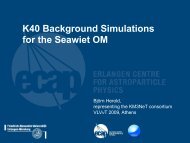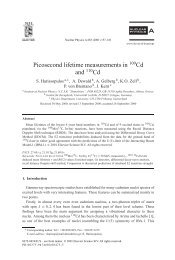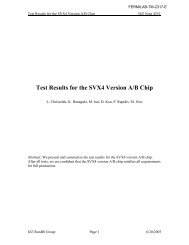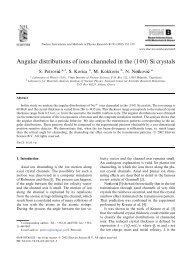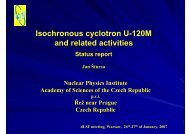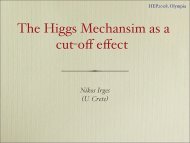Geomorphology and bottom sediments of the Pylos area
Geomorphology and bottom sediments of the Pylos area
Geomorphology and bottom sediments of the Pylos area
Create successful ePaper yourself
Turn your PDF publications into a flip-book with our unique Google optimized e-Paper software.
324<br />
Bottom <strong>sediments</strong>. Sampling or <strong>the</strong> <strong>bottom</strong> <strong>sediments</strong><br />
was carried out by grab "Ocean-50" <strong>and</strong> gravity corer<br />
(diameter 72 mm). In total, geological investigations<br />
was made at 9 stations (Table I), which was located on<br />
<strong>the</strong> comparatively small plateau within isobaths <strong>of</strong><br />
3700 m <strong>and</strong> 3800 m (Fig.6). Preliminary processing <strong>of</strong><br />
<strong>the</strong> <strong>bottom</strong> <strong>sediments</strong> on <strong>the</strong> board included visual<br />
description, selection <strong>of</strong> samples for different<br />
analytical treatments in <strong>the</strong> shore laboratories <strong>and</strong><br />
determination <strong>of</strong> density <strong>and</strong> moisture <strong>of</strong> <strong>the</strong> <strong>sediments</strong><br />
(Table 2). The moisture <strong>of</strong> <strong>sediments</strong> (W) was calculated<br />
using formula W=m I /mIOO%, where m I - mass <strong>of</strong> water in<br />
<strong>bottom</strong> <strong>sediments</strong> <strong>and</strong> m - mass <strong>of</strong> natural <strong>sediments</strong>.<br />
Bottom surface in <strong>the</strong> investigated <strong>area</strong> is covered<br />
by <strong>the</strong> light brownish-grey calcareous mud which<br />
gradually turn into light brown clay within some cm.<br />
Nature <strong>of</strong> <strong>the</strong> upper layer is not changing practically,<br />
density is equal to 1,47-1,49 g/cm 3 , moisture - 49,9-<br />
51,4% (Table 2). Thickness <strong>of</strong> <strong>the</strong> surface layer is<br />
varying from 7 up to 18 cm (Fig. 6). Individual small<br />
black lava pieces are found sometimes on <strong>the</strong> top <strong>of</strong> <strong>the</strong><br />
sediment layer (station AMK-2831). As usual <strong>the</strong> thin<br />
pteropod-forami-niferal layer is underlying at <strong>the</strong><br />
<strong>bottom</strong> <strong>of</strong> clay. Nearly such pteropod layers were<br />
described in a number cores from Mediterranean where<br />
its age determined by<br />
14 C dating was approximately<br />
equal to 3 thous<strong>and</strong>s years (Shimkus,I98I). Below dark<br />
greenish-grey laminated muds with microlayers <strong>and</strong><br />
lenses <strong>of</strong> silt are deposited. The muds are underlying<br />
by bluish-grey to light grey clay with distinctive<br />
spots <strong>and</strong> thin silty laminas in <strong>the</strong> lower part <strong>of</strong>



